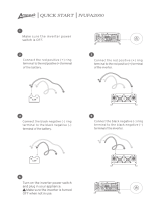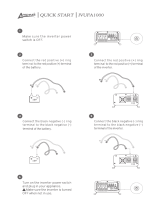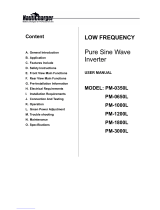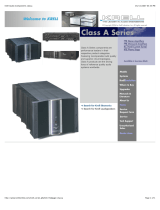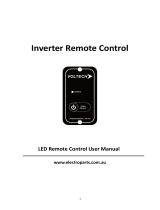Page is loading ...

ST Series
Pure Sine Wave
Power Inverter
User’s Manual

1
Contents
1.
Important Safety Instructions…………………………………………………………………….
2
1-1 General safety precautions…………………………………………………………………… 2
1-2 Precautions when working with Batteries…………………………………………………… 2
2.
Functional Characteristics.……………………………………………………………………….
3
2-1 General Information…………………………………………………………………………. 3
2-2 Application……………………………………………………………………………………. 4
2-3 Features………………………………………………………………………………………. 5
2-4 Electrical Performance………………………………………………………………………. 6
2-5 Mechanical drawings………………………………………………………………………... 10
3.
Introduction.…………………………………………………………………………………………
12
3-1 Front Panel Operation………………………………………………………………………. 12
3-2 Protections Features………………………………………………………………………... 16
3-3 DC Wiring Connections.………….…………………………………………………………. 16
3-4 Hard-wire Installation….………….…………………………………………………………. 20
3-5 Rear panel Operation……………………………………………………………………….. 23
3-6 Installation……………………………………………………………………………………. 23
3-7 Inverter Operation…………………………………………………………………………… 24
4
Information…………………………………………………………………………………………..
25
4-1 Troubleshooting…………………….……………………………….…………………………. 25
4-2 Maintenance………………………………………………………..………………………….. 25
4-3 Warranty………………………………………………………………………………………... 26
5.
Appendices…………………………………………………………………………………………..
27
5-1 FCC (Class A) Declaration of Conformity………………………………………………… 27
5-2 e-mark (e13) Declaration of Conformity………………………………………………….. 29
5-3 EMC (Class A) Declaration of Conformity………………………………………............. 36
5-4 CE (LVD EN60950) Declaration of Conformity…………………………………………... 38
©Copyright: This manual is the copyright of COTEK Electronic Ind. Co., Ltd. And may not be
reproduced or copied without the express permission of the owner.

2
1. Important Safety Instructions
1-1. General Safety Precautions
1-1-1. Do not expose the Inverter to rain, snow, spray, bilge or dust.
To reduce risk of hazard, do not cover or obstruct the ventilation
openings. Do not install the Inverter in a zero-clearance
compartment. Overheating may result.
1-1-2. To avoid a risk of fire and electronic shock. Make sure that existing
wiring is in good electrical condition; and that wire size is not
undersized.
Do not operate the Inverter with damaged or substandard wiring.
1-1-3. This equipment contains components which can produce arcs or
sparks. To prevent fire or explosion do not install in compartments
containing batteries or flammable materials or in locations which
require ignition protected equipment. This includes any space
containing gasoline-powered machinery, fuel tanks, or joints, fittings,
or other connection between components of the fuel system.
1-2. Precautions When Working with Batteries
1-2-1. If battery acid contacts skin or clothing, wash immediately with soap
and water. If acid enters eye, immediately flood eye with running
cold water for at least 20 minutes and get medical attention
immediately.
1-2-2. Never smoke or allow a spark or flame in vicinity of battery or
engine.
1-2-3. Do not drop a metal tool on the battery. The resulting spark or
short-circuit on the battery of other electrical part may cause an
explosion.
1-2-4. Remove personal metal items such as rings, bracelets, necklaces,
and watches when working with a lead-acid battery.
A lead-acid battery produces a short-circuit current high enough to
weld a ring or the like to metal, causing a severe burn.
WARNING!
Before using the Inverter, read and save the safety
instructions.

3
2. Functional Characteristics
2-1. General Information
ST-series completes with stand –alone power inverter with AC transfer
switch and is suitable for RV, Marin and Emergency appliances.
Either mode is front panel programmable.
In the first option, Off-line mode,
A
C output power will be supplied through
the AC bypass mode in its normal operation. Upon AC input failure, output
power will be diverted through the DC to AC Inverter Mode. Once AC
mains are restored, the unit will revert from the Inverter Mode to the
Bypass Mode.
In the second option, On-line mode, AC output power will be provided
directly by the inverter from the DC source. Should the DC source or
inverter fail, the system will transfer its output power through the bypass
mode. Once the DC power source is restored, the system will revert to the
inverter mode.
This power inverter series is a member of the most advanced line of
mobile AC power systems available.
To get the most out of the power inverter, it must be installed and
used properly. Please read the instructions in this manual before
installation and operation this model.
2-2. Application
WARNING!
The above two option are fixed during the production and
customer unable to modify.

4
2-2-1
Power tools–circular saws, drills, grinders, sanders, buffers, weed and
hedge trimmers, air compressors.
2-2-2.
Office equipment – computers, printers, monitors, facsimile machines,
scanners.
2-2-3.
Household items – vacuum cleaners, fans, fluorescent and incandescent
lights, shavers, sewing machines.
2-2-4.
Kitchen appliances – coffee makers, blenders, ice markers, toasters.
2-2-5
Industrial equipment – metal halide lamp, high – pressure sodium lamp.
2-2-6.
Home entertainment electronics – television, VCRs, video games,
stereos, musical instruments, satellite equipment.

5
2-3. Features
■
Pure sine wave output (THD < 3%) to operate higher-end electronic
Equipments.
■
Output frequency:50 / 60Hz switch selectable
■
Built in 16A/25A or 30A rating transfer switch.
■
Speed up transfer time and synchronized operation with the AC source
at all times that allows the transfer to be interruption-free for sensitive
equipments.
■
Built in advance microprocessor to make friendly interface with user.
■
Low power “ Power Saving Mode “ to conserve energy
■
Capable of driving highly reactive & capacitive loads at start moment.
■
Hardwire AC connection model option.
■
Loading controlled cooling fan.
■
Smart remote controller.
■ 3 LED indicators with tri-color display all operation status.
■ High efficiency 88 ~ 94%.
■ Protection:
Input over voltage and Input low voltage protection.
Low battery alarm
Over temperature protection.
Over load protection
Short Circuit protection
Reverse polarity protection.
AC circuit breaker (6Amp to 30Amp)
2-4. Electrical Performance

6
Specification Model No.
Item
ST1000-112 ST1000-124 ST1000-148 ST1000-212 ST1000-224 ST1000-248
Continuous Output Power 1000W
Maximum Output Power (3Min.) 1150W
Surge Rating 2000W
Input Voltage 12V 24V 48V 12V 24V 48V
Output Voltage
100 / 110 / 120V ± 5% 220 / 230 / 240V ± 3%
Frequency
(Switch Selectable)
50 / 60Hz
Output Waveform Pure Sine Wave (THD < 3%)
Efficiency (full load) 88% 90% 92% 90% 93% 94%
No Load Current Draw 1.43A 0.75A 0.38A 1.25A 0.65A 0.35A
Stand-By Current Draw 0.25A 0.15A 0.09A 0.25A 0.15A 0.09A
Input Voltage Regulation
10.5-15
VDC
21.0-30
VDC
42.0-60
VDC
10.5-15
VDC
21.0-30
VDC
42.0-60
VDC
Input Level Indicator
Red / Orange / Green LED
Load Level Indicator
Failure Indicator Red LED
Protection
Overload, Short Circuit, Reverse Polarity (Fuse), Over Temperature
Over/Under Input Voltage, AC Input Circuit Breaker
Circuit Breaker 30 Amp 6 Amp
Remote Control Unit CR6 / CR8 Optional
Synchronous AC transfer YES
Transfer switch 30 Amp 16 Amp
Transfer Time Inverter to utility AC : 8 ~ 10msec. ; Utility AC to inverter : 16 ~ 50 msec
Safety Meet UL458 ------
EMC
EMI Conduction&Radiation Compliance to FCC Class A Compliance to EN55022 classA
EMS Immunity ------ Compliance to EN61000-3-2,3
LVD ------ Compliance to EN60950-1
e-MARK ------ Compliance to e-13*72/245/ECC,95/54 EC
Operating Temperature Range
0 – 40ɗ
Storage Temperature Range
-30ɗ to 70ɗ
Cooling Loading controlled cooling fan
Dimensions 373(L)*236(W)*115(H) mm / 14.7(L)*9.29(W)*4.53(H) Inch
Weight 6.2 kg / 13.6 Lbs.
Note: The specifications are subject to change without notice.
2-4. Electrical Performance
Specification Model No.

7
Item
ST1500-112 ST1500-124 ST1500-148 ST1500-212 ST1500-224 ST1500-248
Continuous Output Power 1500W
Maximum Output Power (3Min.) 1725W
Surge Rating 3000W
Input Voltage 12V 24V 48V 12V 24V 48V
Output Voltage
100 / 110 / 120V ± 5% 220 / 230 / 240V ± 3%
Frequency
(Switch Selectable)
50 / 60Hz
Output Waveform Pure Sine Wave (THD < 3%)
Efficiency (full load) 88% 91% 92% 92% 93% 94%
No Load Current Draw 1.45A 0.75A 0.40A 1.40A 0.70A 0.40A
Stand-By Current Draw 0.28A 0.15A 0.09A 0.28A 0.15A 0.09A
Input Voltage Regulation
10.5-15
VDC
21.0-30
VDC
42.0-60
VDC
10.5-15
VDC
21.0-30
VDC
42.0-60
VDC
Input Level Indicator
Red / Orange / Green LED
Load Level Indicator
Failure Indicator Red LED
Protection
Overload, Short Circuit, Reverse Polarity (Fuse), Over Temperature
Over/Under Input Voltage, AC Input Circuit Breaker
Circuit Breaker 30 Amp 10 Amp
Remote Control Unit CR6 / CR8 Optional
Synchronous AC transfer YES
Transfer switch 30 Amp 10Amp
Transfer Time Inverter to utility AC : 8 ~ 10msec. ; Utility AC to inverter : 16 ~ 50 msec
Safety Meet UL458 ------
EMC
EMI Conduction&Radiation Compliance to FCC Class A Compliance to EN55022 classA
EMS Immunity ------ Compliance to EN61000-3-2,3
LVD ------ Compliance to EN60950-1
e-MARK ------ Compliance to e-13*72/245/ECC,95/54 EC
Operating Temperature Range
0 - 40ɗ
Storage Temperature Range
-30ɗ to 70ɗ
Cooling Loading controlled cooling fan
Dimensions 403(L)*236(W)*115(H) mm / 15.9(L)*9.29(W)*4.53(H) Inch
Weight 7.0 kg / 15.4 Lbs.
Note: The specifications are subject to change without notice.
2-4. Electrical Performance
Specification Model No.

8
Item
ST2000-112 ST2000-124 ST2000-148 ST2000-212 ST2000-224 ST2000-248
Continuous Output Power 2000W
Maximum Output Power (3Min.) 2300W
Surge Rating 4000W
Input Voltage 12V 24V 48V 12V 24V 48V
Output Voltage
100 / 110 / 120V ± 5% 220 / 230 / 240V ± 3%
Frequency
(Switch Selectable)
50 / 60Hz
Output Waveform Pure Sine Wave (THD < 3%)
Efficiency (full load) 88% 91% 92% 90% 93% 94%
No Load Current Draw 2.6A 1.50A 0.70A 2.3A 1.1A 0.65A
Stand-By Current Draw 0.60A 0.30A 0.2A 0.60A 0.3A 0.15A
Input Voltage Regulation
10.5-15
VDC
21.0-30
VDC
42.0-60
VDC
10.5-15
VDC
21.0-30
VDC
42.0-60
VDC
Input Level Indicator
Red / Orange / Green LED
Load Level Indicator
Failure Indicator Red LED
Protection
Overload, Short Circuit, Reverse Polarity (Fuse), Over Temperature
Over/Under Input Voltage, AC Input Circuit Breaker
Circuit Breaker 30Amp
Remote Control Unit CR6 / CR8 Optional
Synchronous AC transfer YES
Transfer switch 30Amp 25 Amp
Transfer Time Inverter to utility AC : 8 ~ 10msec. ; Utility AC to inverter : 16 ~ 50 msec
Safety Meet UL458 ------
EMC
EMI Conduction&Radiation Compliance to FCC Class A Compliance to EN55022 classA
EMS Immunity ------ Compliance to EN61000-3-2,3
LVD ------ Compliance to EN60950-1
e-MARK ------ Compliance to e-13*72/245/ECC,95/54 EC
Operating Temperature Range
0 - 40ɗ
Storage Temperature Range
-30ɗ to 70ɗ
Cooling Loading controlled cooling fan
Dimensions 433(L)*332(W)*115(H) mm / 17(L)*13(W)*4.53(H) Inch
Weight 11.2 kg / 24.6 Lbs.
Note: The specifications are subject to change without notice.
2-4. Electrical Performance
Specification Model No.

9
Item
ST2500-112 ST2500-124 ST2500-148 ST2500-212 ST2500-224 ST2500-248
Continuous Output Power 2500W
Maximum Output Power (3Min.) 2875W
Surge Rating 5000W
Input Voltage 12V 24V 48V 12V 24V 48V
Output Voltage
100 / 110 / 120V ± 5% 220 / 230 / 240V ± 3%
Frequency
(Switch Selectable)
50 / 60Hz
Output Waveform Pure Sine Wave (THD < 3%)
Efficiency (full load) 88% 91% 92% 90% 93% 94%
No Load Current Draw 2.62A 1.53A 0.72A 2.32A 1.15A 0.68A
Stand-By Current Draw 0.60A 0.30A 0.2A 0.60A 0.3A 0.15A
Input Voltage Regulation
10.5-15
VDC
21.0-30
VDC
42.0-60
VDC
10.5-15
VDC
21.0-30
VDC
42.0-60
VDC
Input Level Indicator
Red / Orange / Green LED
Load Level Indicator
Failure Indicator Red LED
Protection
Overload, Short Circuit, Reverse Polarity (Fuse), Over Temperature
Over/Under Input Voltage, AC Input Circuit Breaker
Circuit Breaker 30 Amp
Remote Control Unit CR6 / CR8 Optional
Synchronous AC transfer YES
Transfer switch 30Amp 25 Amp
Transfer Time Inverter to utility AC : 8 ~ 10msec. ; Utility AC to inverter : 16 ~ 50 msec
Safety Meet UL458 ------
EMC
EMI Conduction&Radiation Compliance to FCC Class A Compliance to EN55022 classA
EMS Immunity ------ Compliance to EN61000-3-2,3
LVD ------ Compliance to EN60950-1
e-MARK ------ Compliance to e-13*72/245/ECC,95/54 EC
Operating Temperature Range
0 - 40ɗ
Storage Temperature Range
-30ɗ to 70ɗ
Cooling Loading controlled cooling fan
Dimensions 463(L)*332(W)*115(H) mm / 18.2(L)*13(W)*4.53(H) Inch
Weight 12 kg / 26.4 Lbs.
Note: The specifications are subject to change without notice.
2-5. Mechanical drawings

10
AC INPUT
BREAKER
SSSS
0
1
PWR.
SAV.
FREQ.
1234
POWER
STATUS
INPUT
LEVEL
LOAD
LEVEL
PORT
REMOTE
GND
ENB
ENB
POWER
ON-OFF-REMOTE
DC INPUT
POS(+)NEG(-)
REVERSE POLARITY
WILL DAMAGE UNIT

11
2-5. Mechanical drawings
POS(+)NEG(-)
DC INPUT
POS(+)
WARNING:
REVERSE POLARITY WILL DAMAGE UNIT
NEG(-)
AC INPUT
BREAKER
GND
ENB
ENB
PORT
REMOTE
PWR.
SAV.
FREQ.
POWER
STATUS
INPUT
LEVEL
LOAD
LEVEL
0
1
SSSS
1234
POWER
ON-OFF -REMOTE

12
3. Introduction
3-1. Front Panel Operation
Front view
AC INPUT
BREAKER
SSSS
0
1
PWR.
SAV.
FREQ.
1234
POWER
STATUS
INPUT
LEVEL
LOAD
LEVEL
PORT
REMOTE
GND
ENB
ENB
POWER
ON-OFF-REMOTE
DC INPUT
POS(+)
NEG(-)
REVERSE POLARITY
WILL DAMAGE UNIT
ST-1000/ST-1500
POS(+)NEG(-)
DC INPUT
POS(+)
WARNING:
REVERSE POLARITY WILL DAMAGE UNIT
NEG(-)
AC INPUT
BREAKER
GND
ENB
ENB
PORT
REMOTE
PWR.
SAV.
FREQ.
POWER
STATUS
INPUT
LEVEL
LOAD
LEVEL
0
1
SSSS
1234
POWER
ON-OFF-REMOTE
ST-2000/ST-2500
3-1-1. Power ON / OFF / REMOTE (Main) switch:
a. Before installing the inverter, you need to ensure the main switch
is in the OFF position.
b. Before using the remote unit, you need to ensure the main switch
is in the REMOTE position.
3-1-2. AC input Circuit Breaker:
The AC input circuit breaker protects the model from overload.
When an overload condition exists, the circuit breaker stops to supply
output AC grid power. To reset it, push the circuit breaker switch
then the model will be back in normal operation. The source fault
should be corrected before you reset it.

13
3-1-3 Green terminal
1) Before installing the inverter, you need to ensure the main switch must
be ”OFF”.
2) Before using the remote control terminal, you need to ensure the main
switch muse be “REMOTE”.
3) Ensure the remote contacts off.
4) Use 20 ~ 24 #AWG wire to connect the remote control terminal.
5) Remote control ON/OFF inverter setup status:
ENB
GND
ON:INV. ON
OFF:INV. OFF
LOW:INV. OFF
HI:INV. ON
GND
ENB
TR
(TR ON)
(TR OFF)
OFF:INV. OFF
ON:INV. ON
ENB
BAT+
BAT-
GND
ON:INV. ON
OFF:INV. OFF
ENB
+
-
DC
POWER
NOTE: At the same time, only can use one model to control the inverter.
The maximum level is the same as input DC voltage.
3-1-4. Remote Port:
The ST Series Inverter is compatible with any of these remote
controllers: CR-6 or CR-8.
3-1-5. Input Level:Display Input Voltages
LED Status DC 12V DC 24V DC 48V
RED Blink (slow) 10.3~10.6 20.5~21.2 40.8~42.4
RED 10.6~11.0 21.2~21.8 42.4~43.5
ORANGE 11.0~12.1 21.8~24.1 43.5~48.1
GREEN 12.1~14.2 24.1~28.6 48.1~56.3
ORANGE Blink 14.2~15.0 28.6~30.0 56.3~59.6
OVER RED BLINK 15.0q 30.0q 59.6q

14
3-1-6. Load Level:Display AC Loads (Watts)
LED Status DARK GREEN ORANGE RED
BLINKING
RED
ST1000
0 ~ 80W 80 ~ 330W 330 ~ 750W 750 ~ 960W Over 960W
ST1500
0 ~ 120W 120 ~ 495W 495 ~ 1125W 1125 ~ 1450W Over 1450W
ST2000
0 ~ 160W 160 ~ 660W 660 ~ 1500W 1500 ~ 1920W Over 1920W
ST2500
0 ~ 200W 200 ~ 825W 825 ~ 1875W 1875 ~ 2390W Over 2390W
3-1-7. Power Status:Display Power & Fault Status
Orange LED LED Signal Status
Solid Power OK
Slow Blink Power Saving
Red LED LED Signal Status
Fast Blink OVP
Slow Blink UVP
Intermittent Blink
OTP
Solid OLP
Green LED LED Signal Status
Solid AC GRID INPUT OK
3-1-8. AC Frequency:Selected by “S4” Dip Switch
Frequency S4
50 HZ OFF
60 HZ ON
3-1-9. Power Saving Mode: Power Saving Mode is adjustable and
set by the Dip Switches, S1, S2 and S3 on the front panel.
Example: The load should be set above15W. If the load is below15W,
the power saving mode will be activated.

15
ST1000
ST1500
ST2000
ST2500
S1 S2 S3
DISABLE DISABLE OFF OFF OFF
20W 40W ON OFF OFF
40W 80W OFF ON OFF
55W 125W ON ON OFF
75W 170W OFF OFF ON
95W 210W ON OFF ON
115W 245W OFF ON ON
135W 280W ON ON ON
3-1-10. DC Input Terminals:
Connect DC input terminals to 12V / 24V / 48V battery or other
power sources.
[ + ] represents positive, [ - ] represents negative. Reverse polarity
connection can blow the internal fuse and may damage the inverter
permanently.
Model
DC Input Voltage
Minimum Maximum
12V 10.5V 15.0V
24V 21.0V 30.0V
48V 42.0V 60.0V
3-1-11. Chassis Ground: Connect the wire # 8 AWG to vehicle chassis.
WARNING!
Operating the inverter without a proper ground
connection may cause electrical safety hazard.

16
3-2. Protections Features
Model
DC Input (VDC) Over Temperature Protection
Over Voltage Under
Voltage
Alarm
Under Voltage INTERIOR HEAT SINK
Shut-
down
Restart Shut-
down
Restart Shut-
down
Restart Shut-
down
Restart
12V 15.3 14.3 11.0 10.2 12.7
70℃ 45℃ 90℃ 60℃
24V 30.6 28.6 22.0 20.3 25.2
48V 61.2 57.2 44.0 40.8 49.7
3-3 DC Wiring Connections
Follow the instructions to connect the battery cables to DC input terminals of
the Inverter. The cable should be as short as possible (less than 6 feet / 1.8
meters ideally) so that it can handle the required current in accordance with
the electrical codes or regulations application. Inappropriate length of cables
will deteriorate the inverter performance such as poor surge capability,
frequent low-input voltage warnings, and shutdown. UVP warning occurs
when DC voltage drops across the cables from the inverter to the batteries.
The longer or narrower the cables, the more the voltage drop.
Increasing your DC cable size will help improve the situation.
The following recommended cables are for the best performance of the
inverter. (Apply both 120V and 230V versions)
Model No Wire AWG Inline Fuse
ST1000-112 / 212 # 2 150
A
ST1000-124 / 224 # 4 80
A
ST1000-148 / 248 # 6 40 A
ST1500-112 / 212 # 2 200
A
ST1500-124 / 224 # 4 100
A
ST1500-148 / 248 # 6 50
A
ST2000-112 / 212 # 2/0 250
A
ST2000-124 / 224 # 1/0 125
A
ST2000-148 / 248 # 2 70
A
ST2500-112
/
212 # 4/0 400
A
ST2500-124 / 224 # 2/0 200
A
ST2500-148 / 248 # 1/0 100
A

17
3-3-1. Connect the cables to the power input terminals on the front panel of the
inverter. The red terminal is positive (+) and black terminal is negative (-).
Insert the cables into the terminals and tighten screw to clamp the wires
securely.
Also, only use high quality copper wire and keep the cable length short
which is a maximum of 3 - 6 feet.
Do not place anything between
battery cable lug and terminal surface.
Assemble exactly as shown.
AWG#2 - #6
Battery to inverter cable connection
WARNING!
The installation of a fuse must be on positive cable.
Failure to place a fuse on “+” cables running between
the inverter and battery may cause damage to the
inverter and will void warranty.
WARNING!
Make sure all the DC connections are tight (torque
to 9 – 10 ft-lbs, 11.7 – 13 Nm). Loose connections
could result overheat in a potential hazard.

18
INLINE FUSE
P
O
S
(
+
)
N
E
G
(
-
)
PLASTIC COVER
RING TERMINAL
WASHER
M8 NUT
SPRING WASHER
PVC WIREġ
WASHER
RING TERMINAL
M8 NUT
SPRING WASHER
Do not place anything between
battery cable lug and terminal surface.
Assemble exactly as shown.
ST-1000
ST-1500

19
INLINE FUSE
POS(+) NEG(-)
WARNING: REVERSE POLARITY WILL DAMAGE UNIT
DC INPUT
POWER
ON-OFF-REMOTE
REMOTE
PORT
0
I
INPUT
LEVEL
0
1
AC INPUT
BREAKER
LOAD
LEVEL
S
1
S
2
S
3
S
4
POWER
STATUS
ST2000
ST2500
/
